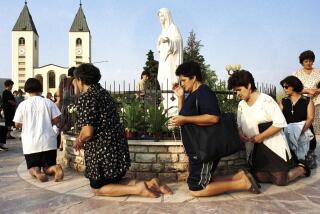Satanism Still Strong, Controversial Priest Tells Diocese Crowd
- Share via
ORANGE — The teen-age girl was understandably concerned. She had just listened to Father James LeBar give an hourlong talk on satanism and exorcism Saturday. Afterward, the youth approached the Catholic priest in a crowded hallway at the Diocese of Orange’s Marywood Center.
In bed at night she could feel a lingering evil, she told the priest. The girl said she could hear demonic growling in her ears.
LeBar, a nationally recognized expert on satanism and cults, was hardly surprised by the revelation. The priest saw no reason for concern. The girl was devoutly wearing her religious medallion and attending church services. She had “chased the devil away,” he told her.
So it goes these days for the unassuming, bespectacled priest from Poughkeepsie, N.Y. LeBar, who spoke Saturday during a daylong conference at Marywood Center on cults and satanism, is much in demand since he paved the way for a film crew from the ABC-TV program “20/20” to shoot the recent exorcism of a 16-year-old girl.
The 26-minute segment, aired earlier this month, showed a Miami teen-ager named Gina being tied down as an anonymous priest performed the ritual. The girl screams, spits and retches, shouts epithets and pleads to be released.
At one point she says: “I don’t want to burn. Sinners. The world is getting worse. More wars are coming. Do you understand? Jesus is going to take all of us. Going to burn a lot of people.”
Though the segment was attacked by critics both inside and outside the church, LeBar contended Saturday that it helped clear up a lot of misconceptions about exorcism. In particular, it pointed out that several alternatives--including psychological consultations--must be exhausted before one can receive a church-sanctioned exorcism, which must be approved by a Catholic bishop.
LeBar said he agreed to allow the film crew to attend the exorcism in an effort to encourage belief in the existence of the devil, prompt troubled souls to first seek medical or psychiatric treatment and demonstrate how the church may be able to help if those other methods fail.
But many church figures criticized the television program as being too sensational and exploitative. Among the most vocal was Father Richard McBrien, head of the theology department at the University of Notre Dame, who voiced fears that an emphasis on exorcism could hurt the church’s credibility and deflect attention from more common manifestations of evil such as hunger, homelessness and war.
LeBar, chaplain for the Hudson River Psychiatric Center, kicked off his talk Saturday by declaring that the whirlwind events surrounding the April 5 broadcast, including a guest appearance on ABC’s “Nightline” to debate McBrien, had been a “wonderful experience” and that “our aim was accomplished.”
With feature films such as “The Exorcist” and television programs, “there’s not anyone in the world who doesn’t know about exorcism and the devil,” LeBar told the crowd of about 200 parishioners, priests and nuns in the center’s auditorium.
Satanism is nothing new. Exorcisms have been performed for centuries, LeBar noted, recounting tales of beds bounced around a room by an angry demon, the possessed floating to the ceiling and exorcists who have described seeing Lucifer standing with a crown and fiery sword.
LeBar said he, too, has met the devil face on. The priest recalled the day he first saw Gina, the Florida girl featured in the “20/20” episode. A growling, guttural voice from another world seemed to be emptying from her mouth, he said.
The priest asked who was talking. The girl refused. Then she displayed what seemed one of the reputed characteristics of possession: clairvoyance. Without prompting, the girl told the priest that a colleague in Rome would not be able to come to the United States to perform an exorcism.
LeBar said he later found out that it was true. A priest he was counting on had been hospitalized in Italy and would not be able to make the trip.
“How could that 16-year-old girl have known that?” LeBar wondered softly. “Obviously, she didn’t. It was the devil.”
During the subsequent exorcism performed by another Catholic priest, objects rattled on the shelves in the room, “which spooked a few people,” LeBar told his audience. In the weeks before, the girl’s mother had reported that Gina seemed at times to be floating off the ground when she walked.
LeBar said there are four signs of possession by the devil: unnatural strength, an ability to speak languages one has never studied, clairvoyance and levitation. Moreover, people occupied by the devil typically are repulsed by the sight of a cross, are unable to stomach holy water and staunchly refuse to enter a sanctified place of worship, he maintained.
But he said the devil can be tricky. At times, a possessed person has been known to take Communion, as if the demonic force inside is trying to throw church investigators off the track, LeBar said.
He stressed that possession by the devil is rare. Nonetheless, in 1990 alone the Archdiocese of New York opened 70 cases on people suspected of being possessed, LeBar said. So far, only a handful have led to actual exorcism.
“There are many who don’t want to believe there is such a person, such a creature as the devil,” noted LeBar, adding that many critics of the “20/20” episode were put off because the exorcism was too pedestrian compared to events depicted in films such as “The Exorcist.”
“They wanted to see green vomit, the levitation, her head spinning around,” LeBar said. “I’m just happy I didn’t see that.”
While possession and exorcism capture the imagination, other forms of “diabolic activity” pose a far more pressing concern in the world today, LeBar said. In particular, he cited the breakup and escalation of violence within families, the faltering ranks of churchgoing youth and the inability of the Catholic Church to make headway in its fight against abortion.
Echoing a common theme that has rippled through the hearing rooms of Congress in recent years, the priest noted that heavy metal music is a wellspring of satanism.
Youths also “invite the devil” into their lives with “Ouija boards, Tarot cards, fortunetellers, things like that,” he maintained.
LeBar recalled talking with one 18-year-old who used a Ouija board to find a girlfriend and a new job. But the young man also recounted how the board one day seemingly flew out of his hand and broke a window. Another day, the board’s marker began moving on its own accord, spelling out d-e-a-t before the youth brushed the marker off the table. He didn’t want to see it spell out death.
“The only one who can reveal hidden knowledge besides God is the devil,” intoned LeBar.
While worship of the devil once remained cloaked on the edges of society, today there are churches of Satan registered with the government, he said. Charles Manson and “Son of Sam” killer David Berkowitz both were members of a satanic church, LeBar said.
“I don’t see the devil in every nook and cranny, under every pebble,” LeBar concluded. “But ultimately the devil is the source of evil.”
More to Read
Sign up for Essential California
The most important California stories and recommendations in your inbox every morning.
You may occasionally receive promotional content from the Los Angeles Times.










